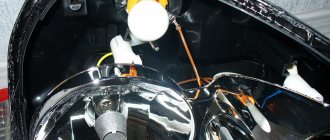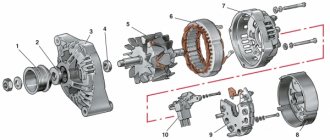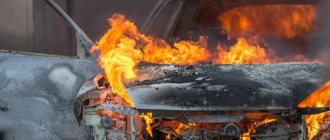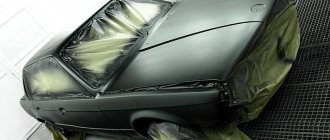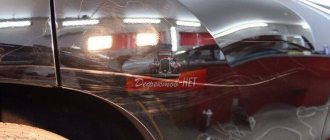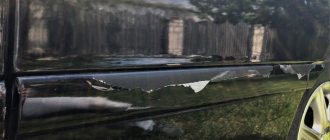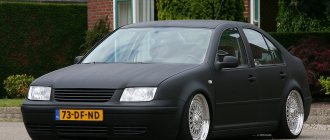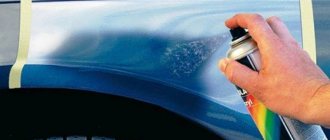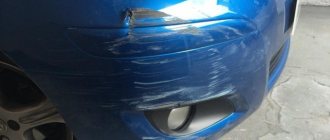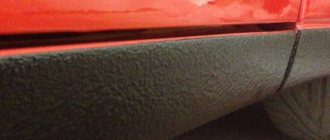Let's figure out whether to choose acidic or epoxy primer. In what cases, which one to use. And also how to use it correctly.
There is such an English word primer (prime: first, initial, primary). These two soils are primary. It is even more correct to call them primers, but the word “primer” is also applicable, since they perform the functions of a primer. Acrylic fill primer, for example, is called filler and is not a primary primer.
What is epoxy primer
Epoxy-based primer belongs to the class of two-component paint coatings designed to protect metal coatings from corrosion. They are produced in metal cans of various capacities or in the form of an aerosol. The last type of substance differs from the canned variety only in the method of application.
Anti-corrosion epoxy primer Ranal EP
Epoxy primer: properties, advantages, disadvantages
Epoxy primer for metal for cars is essentially a multifunctional substance, but the main function is to protect the surface from corrosion and improve adhesion.
In addition, a substance of this type is often used as a thermoplastic insulator. Such qualities are ensured due to the composition - special chemicals and epoxy resins.
Automotive epoxy primer has both advantages and disadvantages. The positive qualities include the following:
- resistance to external mechanical damage;
- does not allow water to pass through;
- provides excellent adhesion;
- plastic and durable;
- heat resistant;
- durable;
- layers lay down evenly and dry quickly;
- environmental friendliness - despite the fact that the composition contains a huge number of chemical elements, the substance does not pose a danger to the environment and human health. But you should still take precautions when working with the substance.
Automotive epoxy primer Reoflex 0.8 l + hardener 0.2 l
There are also negative sides:
- the epoxy base takes a long time to dry - at a temperature of about 20 degrees, complete drying will take at least 12 hours;
- You cannot use high-temperature drying - as bubbles and cracks will form on the surface, which will make further high-quality painting impossible.
Therefore, you can only use epoxy primer for metal if you have time.
Classification
There are quite a few varieties of this substance - each manufacturer produces several subspecies. In general, epoxy primer for metal is divided into two types:
- one-component - such a primer does not contain a hardener, which adds one, but significant disadvantage - it takes too long to dry;
- two- or multi-component - the composition includes high-quality hardeners, so the drying process is much faster - about 12 hours. Moreover, excellent value for money.
The primer is available in metal cans and in aerosol form.
Epoxy primer in a can
Selecting and applying a primer
When the surface geometry has been completely recreated, you can begin to treat with primer, which will ensure reliable adhesion of the paint layer. Before this, a few words have already been said about the properties of the primer, which mainly determine its classification. Let's consider its types in more detail.
- Epoxy. This is a liquid mixture containing chromium plating or inert substances. Used to counteract moisture and other aggressive compounds. Such primers (for example, GF21, FL-OZK) do not require finishing sanding. Except for cases where the paintwork has visible defects (drips).
- Primer. This is the so-called primary primer, or leveler. It is used for anti-corrosion treatment (can be applied before puttying) and improving adhesion.
- Sealant. This is the finishing layer of primer, which is designed to protect it and deactivate the solvent properties of the paint.
To apply the primer, you can use paint guns or spray guns, in which liquid is sprayed under a pressure of at least 2 atmospheres. Before doing this, it is recommended to clean the surface without fail and apply anti-silicone to degrease. Primary primers are usually applied in 2 thin layers, between which a pause of up to one and a half hours of drying is required. After this, secondary soil is applied 3 layers thick. Before applying the next layer, wait up to 10 minutes to allow the liquid to dry and become matte.
The process of painting car body elements is a rather painstaking task, which must necessarily combine such steps as primer and putty. The quality of all work done to prepare the car for painting largely depends on their choice, the correct order of their application and the correct combination.
Scope of use
Painting with epoxy primer is in demand not only when working on a vehicle - this type of substance can be used to coat other large objects, but only metal ones.
Important! The primer for concrete work should not be confused with the one used for metal work. These are completely different products in composition, and the result of the work can be unpredictable, not in the positive sense of the word.
In general, “epoxy” can be used in the following cases:
- on top of “bare” metal - it can be either steel or aluminum;
- over a mixed surface - with putty;
- as a final insulating layer;
- as a means of improving surface resistance to mechanical damage;
- application to fiberglass parts, but only as the first layer.
In any case, before you start treating the surface, you need to carefully read the instructions and make sure that this particular type of primer is suitable for a particular type of surface.
Epoxy primer for metal SG 34
Features of epoxy auto primer
Epoxy resin primer is a type of two-component universal liquid paint coating. Their main goal is to create a protective and highly corrosion-resistant layer on the metal surface being processed and to increase adhesive qualities. The primer is produced in jars (containers) of various sizes; there are also options for aerosol tubes. This composition also acts as a highly effective thermoplastic insulating coating layer.
Surface for epoxy primer
Before processing, you should properly prepare the surface - this way epoxy primer for cars adheres much better. The work algorithm is approximately as follows:
- clean the body from old paintwork and rust using a sandblaster or grinder;
- if necessary, carry out mechanical straightening;
- degrease the surface;
- treat the surface with anti-corrosion agents;
- defects need to be puttied;
- After the putty has dried, sand the surface.
Important: when working with the substance, you must follow safety precautions. The primer must be used strictly according to the manufacturer's instructions. Drafts and dust should not be allowed to form in the room.
Features of using aerosol
Epoxy primer in the form of an aerosol is used as an anti-corrosion coating; it should be used on the following surfaces:
- galvanized;
- made of ferrous metal;
- light alloy.
Can also be used as a base for various enamels.
Epoxy primer in aerosol form
Important! The following types of enamels are incompatible with this type of epoxy primer:
- alkyd-acrylic;
- alkyd-urethane;
- polyvinyl chloride.
It is better to use soil in such a container to eliminate small defects.
The surface must be prepared according to the algorithm described above. The further work algorithm is as follows:
- The can must be shaken well;
- spraying should be carried out at an angle of 90 degrees;
- the balloon dispenser should be located at a distance of 20–30 cm from the surface to be treated;
- the substance should be applied in 2-3 layers with a time interval of 25–30 minutes;
- You need to spray the primer smoothly, without stopping in one place.
Important! Use protective equipment while working (respirator, gloves).
BOLL Epoxy primer in aerosol 500ml
Advantages
According to experts, the main positive quality of epoxy-based soil (regardless of its shape) is the ability to withstand significant temperature fluctuations, atmospheric and mechanical loads.
The second important property is the minimum drying time, which makes using the composition as convenient as possible. This trifecta of advantages is completed by adhesion; the applied composition firmly adheres to the metal.
The treated body retains all visual features and technological characteristics for a long time.
Practice shows that the epoxy composition is suitable even for metal surfaces that are in constant contact with water, so it can provide the highest level of corrosion resistance to a car that is in contact with moisture only periodically.
Classification Features
The number of compositions presented on the modern market amounts to dozens; they can be classified according to a variety of technological and operational indicators, be it the degree of adhesion or the effect on the metal. However, this division is not the most significant.
The most important factor is the composition, which allows the products to be divided into two large groups:
- One-component . The composition does not contain a hardener, which increases the drying time. This is inconvenient when treating a vehicle, so solutions are not widely used;
- Two-component (multi-component). A hardener must be added to the composition, due to which the drying time is significantly reduced.
Primers in aerosol form
This group of products should be considered separately. The price of primer in a can is higher compared to its analogues in ordinary metal containers, however, it has an undeniable advantage - ease of use.
There is no need for dilution or additional purchase of solvents, pigments and other additives. The aerosol is immediately ready for use; you just need to shake the can vigorously before spraying, or perform other simple steps indicated by the manufacturer.
If it is planned to process the entire vehicle body, the use of an aerosol is not economically feasible; the financial investment will be too significant.
Another thing is the repair of individual sections of the body, be it metal sills or fenders. In such a situation, a spray can is the optimal solution, thanks to which you will be able to save a lot of time and money, carry out restoration on your own, without purchasing auxiliary materials or contacting specialists.
Useful video on why epoxy primer is in cylinders:
Famous brands
As already noted, there are many primers available in stores. Without experience, it is extremely difficult to find a solution that will be truly durable and reliable, capable of protecting the car body from external negative factors.
However, based on reviews from drivers and service center specialists, some conclusions can be drawn.
Novol soil (Protect 360), produced by the Polish brand of the same name, has a good reputation. Yes, this product is more expensive than many of its analogues, but the high cost is fully compensated by the quality.
Practice shows that the composition is suitable for treating metal surfaces, even those in poor condition, covered with significant areas of intense corrosion.
For example, it is soil from Poland that is used by many commercial enterprises specializing in passenger or cargo transportation.
The solution promotes maximum protection of metal from rust and temperature fluctuations, extending the life of vehicles. Increases the overall profitability of the enterprise by reducing costs associated with repairs and machine downtime.
Video, technical information for Novol epoxy primer:
Among the budget solutions, we can highlight the Russian Reoflex , the instructions for use of which are quite standard. Experts note the optimal consistency of the composition, which simplifies work, as well as decent corrosion protection characteristics, quite comparable with more expensive brands.
Primer for car
In order for the surface to be processed correctly and efficiently, the type of soil must be selected correctly. There are many of them on the market, let’s highlight the most popular ones:
- acrylic - used not only for metal, but also for plastic and wood. Excellent resistance to temperature changes, moisture and other negative factors;
- anti-corrosion - not only protects the surface from corrosion, but also improves the adhesion of paint to the surface;
- strengthening – used to eliminate various types of defects, also characterized by high adhesion rates;
- acidic for metal - “corrodes” a thin layer of metal to improve the adhesion of paint to the surface.
It is advantageous to use an epoxy-type primer because it combines several functions at once.
How to prime a car body
If you plan to work with small defects, a spray can is quite suitable. The primer in a metal can must first be mixed with a solvent and, if necessary, a hardener. The latter is necessary if a one-component type of product is used.
The substance must be thoroughly stirred until smooth. The hardener must be added in stages, depending on the number of layers applied.
Car body primer
The composition must be diluted strictly as written in the instructions. You need to apply the substance with a roller or brush; you can also use a spray gun. The primer is applied with a brush or roller, taking into account the following rules:
- the first layer is very thin;
- After 15 minutes you can apply the second layer, and after another 15 minutes the third layer. Without reference to a time interval - you can apply a new layer when the previous one becomes matte;
- you need to apply the substance smoothly, but without staying in one place for a long time;
- Avoid abrupt transitions and gaps.
Using a spray gun, apply the primer as follows:
- the first layer should be thin and even, so the distance from the surface to the sprayer should be 20–30 cm;
- In order for the substance to be evenly distributed over the surface, the movements must be cross.
With this technology of applying the substance, there may be smudges and other minor defects, which can be easily removed by sanding before painting.
The room where the car surface is being primed should be free of dust, drafts and dirt. It is better if the lighting is daylight spectrum, of moderate brightness.
Priming a car before painting
If you plan to prime not the entire car, but only individual parts, the “non-working” areas must be covered with film and masking tape. The windows and headlights must also be covered.
Important! Do not forget about personal protective equipment while working!
